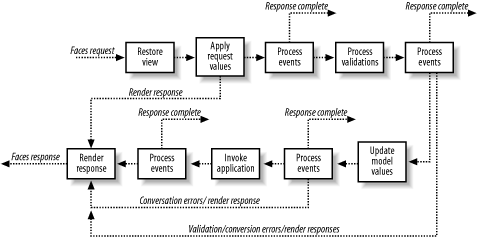18.2 Overview of JSF Architecture
| The architecture of JSF is not completely unlike other MVC architectures you've probably encountered when building web applications. In fact, some of its pieces should be quite familiar now that you've read this book. However, JFS adds functionality in several places where Struts is lacking, and it does so a way that separates interface from implementation. As stated earlier, this is an important (but often overlooked) quality. Because it's built around the MVC concept, you might expect to see models, views, and controllers in JSF. And while these elements are all present in JSF, the web imposes some distinct limitations on the MVC model. Let's look at a simplified scenario of how a traditional MVC architecture works:
Unfortunately, these steps don't work in the web world. Web browsers rarely sit and wait for an event to be published. Instead, they make a request for information and then expect that information to be returned they are certainly not preconditioned to listen for events. JSF's approach is to provide components to handle the controller aspects of the application. These include the FrontController (similar to the Struts ActionServlet), NavigationHandler, conversion and formatting components, ActionListeners to interpret the commands, and validate the presentation data. JSF also provides components for the view. These are implemented as client-specific rendering kits made up of renderers. These renderers know how to make items such as a buttons or text fields in a browser. JSF contains these essential ingredients:
18.2.1 The JSF Request/Response LifecycleA JSF application supports two types of requests and two types of responses:
According to the specification, these different requests and responses result in three possible lifecycles for a JSF application:
Figure 18-1 illustrates the request/response lifecycle for the standard scenario. Figure 18-1. The standard JSF request/response lifecycle As mentioned earlier, there are more similarities than differences between JSF and Struts. The low-level components within JSF sound a great deal like the components included with the Struts tag libraries. In fact, there's a great deal of overlap between these seemingly disparate technologies, and Craig McClanahan has publicly announced that he plans on a seamless integration of JSF and Struts. The goal is to allow you to replace the use of some of the Struts tags in your application with UI components of JSF, while continuing to utilize the Struts Controller and Action classes. You might imagine how a JSF Front controller could pass a request on to the Struts RequestProcessor to perform some business service on its behalf. This process is indicated in the "Invoke application" step in Figure 18-1. |
EAN: 2147483647
Pages: 180